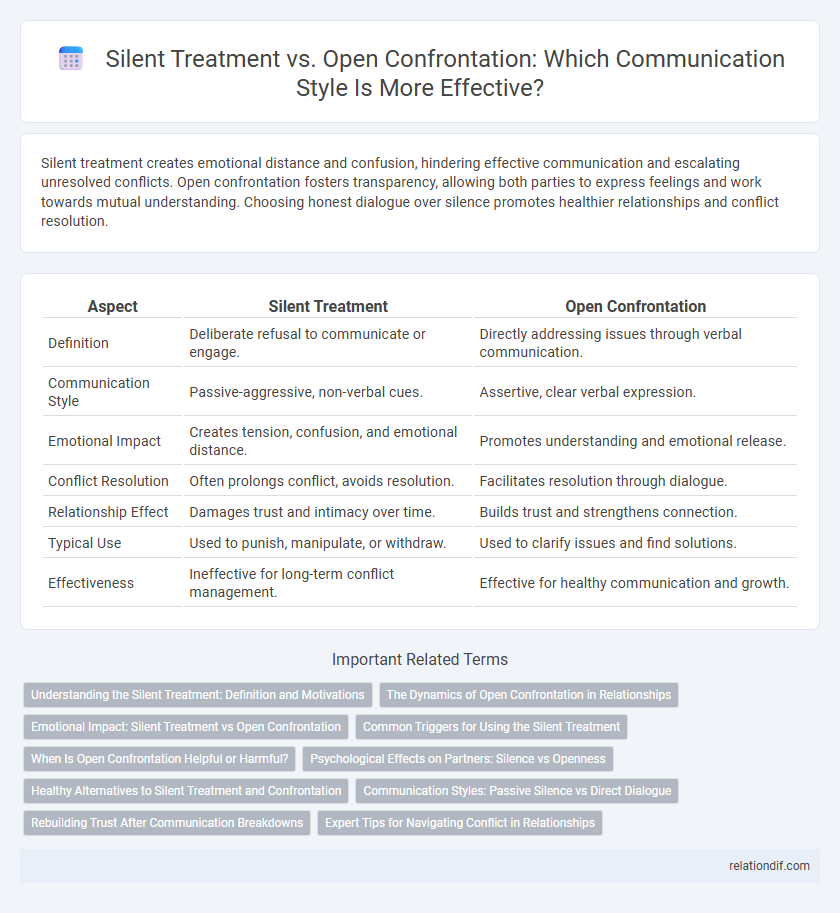Silent treatment creates emotional distance and confusion, hindering effective communication and escalating unresolved conflicts. Open confrontation fosters transparency, allowing both parties to express feelings and work towards mutual understanding. Choosing honest dialogue over silence promotes healthier relationships and conflict resolution.
Table of Comparison
| Aspect | Silent Treatment | Open Confrontation |
|---|---|---|
| Definition | Deliberate refusal to communicate or engage. | Directly addressing issues through verbal communication. |
| Communication Style | Passive-aggressive, non-verbal cues. | Assertive, clear verbal expression. |
| Emotional Impact | Creates tension, confusion, and emotional distance. | Promotes understanding and emotional release. |
| Conflict Resolution | Often prolongs conflict, avoids resolution. | Facilitates resolution through dialogue. |
| Relationship Effect | Damages trust and intimacy over time. | Builds trust and strengthens connection. |
| Typical Use | Used to punish, manipulate, or withdraw. | Used to clarify issues and find solutions. |
| Effectiveness | Ineffective for long-term conflict management. | Effective for healthy communication and growth. |
Understanding the Silent Treatment: Definition and Motivations
The silent treatment refers to deliberately ignoring or refusing to communicate with someone as a form of emotional punishment or control, often rooted in feelings of anger, frustration, or power imbalance. This nonverbal behavior can signal unresolved conflict or deeper emotional distress while aiming to elicit a reaction or compliance from the other party. Understanding the silent treatment's motivations helps identify underlying issues and promotes healthier communication strategies.
The Dynamics of Open Confrontation in Relationships
Open confrontation in relationships fosters clear communication by addressing issues directly, reducing misunderstandings and building trust. This dynamic encourages emotional honesty and accountability, allowing partners to resolve conflicts constructively. Unlike the silent treatment, open confrontation helps maintain connection and promotes long-term relational health.
Emotional Impact: Silent Treatment vs Open Confrontation
The emotional impact of silent treatment often leads to feelings of isolation, confusion, and increased anxiety, as the lack of communication creates uncertainty and emotional distress. In contrast, open confrontation encourages emotional expression and resolution, promoting understanding and emotional relief despite initial discomfort. Effective communication strategies prioritize transparency and empathy to mitigate negative emotions associated with conflict.
Common Triggers for Using the Silent Treatment
Common triggers for using the silent treatment include feelings of hurt, frustration, or perceived disrespect during conflicts. People often resort to silence as a defense mechanism to avoid escalation or express dissatisfaction indirectly. Recognizing these triggers helps facilitate healthier communication and encourages open confrontation instead.
When Is Open Confrontation Helpful or Harmful?
Open confrontation can be helpful when addressing misunderstandings promptly to prevent resentment and foster transparent communication, especially in professional or close personal relationships where trust is essential. However, it becomes harmful if emotions escalate unchecked, leading to aggression or further conflict that damages relationships rather than resolving issues. Choosing open confrontation requires assessing emotional readiness and the potential for constructive dialogue to ensure it promotes healing rather than harm.
Psychological Effects on Partners: Silence vs Openness
Silent treatment often leads to increased anxiety, confusion, and feelings of rejection in partners, fostering emotional distance and unresolved tension. In contrast, open confrontation encourages emotional expression and active problem-solving, promoting mutual understanding and relationship resilience. Psychological research highlights that openness reduces stress and enhances emotional intimacy, whereas silence perpetuates negative emotions and erodes trust.
Healthy Alternatives to Silent Treatment and Confrontation
Healthy alternatives to silent treatment and open confrontation include assertive communication techniques that emphasize expressing feelings calmly and clearly without blame. Practicing active listening fosters understanding and reduces conflict by validating emotions and perspectives. Setting boundaries and using "I" statements promotes respectful dialogue and problem-solving in relationships.
Communication Styles: Passive Silence vs Direct Dialogue
Passive silence in communication often leads to unresolved conflicts and emotional distance, as individuals with this style avoid expressing their feelings or concerns. Direct dialogue encourages transparent exchanges and immediate resolution, fostering trust and understanding through honest verbal interaction. Choosing open confrontation over silent treatment enhances relationship dynamics by promoting clarity and emotional health.
Rebuilding Trust After Communication Breakdowns
Rebuilding trust after communication breakdowns requires addressing the silent treatment by fostering open confrontation that encourages honest dialogue and emotional expression. Transparent communication helps clarify misunderstandings and demonstrates accountability, essential for restoring confidence within relationships. Consistent, empathetic exchanges create a foundation for mutual respect and long-term trust renewal.
Expert Tips for Navigating Conflict in Relationships
Experts recommend addressing conflicts with open communication to foster trust and understanding, as the silent treatment often exacerbates misunderstandings and emotional distance. Effective conflict resolution strategies include active listening, expressing feelings calmly, and seeking mutual solutions in relationships. Prioritizing transparency and empathy helps partners navigate disagreements constructively and strengthen their emotional connection.
silent treatment vs open confrontation Infographic

 relationdif.com
relationdif.com